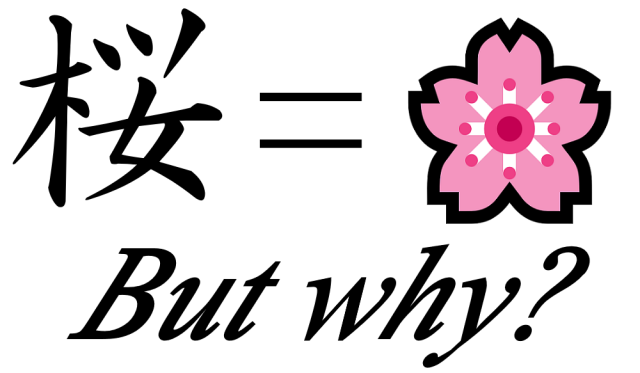
There’s a beautiful reason why the kanji for cherry blossoms looks the way it does, and remembering it makes the character a snap to write.
With cherry blossom season in full swing here in the Tokyo area, it’s a great time to look at sakura, so let’s do that right now…and by that I mean let’s look at the Japanese kanji character for sakura.
Beautiful, isn’t it? Unfortunately, the same artistic qualities that make kanji so beautiful to look at can also make them a huge pain in the butt to write, since you can’t exactly remember how to “spell” a picture. However, you can make things a lot easier by breaking each kanji down into its component parts, and if you know why those parts were chosen to represent that word, the whole thing becomes easier still.
So let’s take a look at what goes into the sakura kanji, and luckily everything is there for a pretty logical reason. To start with, we’ll shift from the brush stroke-style seen above to block printing, which should make things a little easier to see.
We’ve got three sections to look at, so let’s circle those right away.
When writing the sakura kanji, the part circled in blue comes first, so that’s where we’ll start answering the question of “Why?”
This part, with a tall trunk standing in the middle and branches coming off of it, represents a tree. That makes sense, right? After all, sakura is both the word for cherry blossoms and the non-fruit-bearing cherry trees the flowers grow on.
This first section of the sakura kanji has four strokes, and the order you write them in (as well as the direction your pen/brush should move) are shown below.
Next, let’s hop on over to the top-right section.
The Japanese language throws us a bone here. Long ago, this section was a lot more complicated than these three little lines, and the sakura kanji looked like this:
By itself, 貝 is the kanji for shell, but two of them together like this signifies a necklace, as shiny shells were some of humanities earliest accessories, back in the days before mining and polishing gemstones were beyond craftsmen’s capabilities. Eventually, though, even Japan thought the old-school sakura kanji was taking too long to write, and so they simplified the upper right section into what we see in the standard sakura kanji used today, proving that “Dude, come on, you know what I’m trying to say, right?” is something that even our cultured ancestors sometimes thought (although the more complex sakura kanji does still show up today in some family names).
▼ While it’s not the real reason they’re there, it’s also a handy mnemonic device to think of the three lines as a trio of cherry blossom petals fluttering gently in a spring breeze.
And finally, let’s head down to the bottom-right portion and finish the sakura kanji off.
By itself, 女 is the kanji for “woman,” which originated as a drawing of a woman with her hands folded while elegantly kneeling Japanese-style. It’s a bit of an abstract rendering, but it’s still pretty easy to see 女 as a picture of a person with easily identifiable arms, legs, torso, and neck.
▼ The first stroke for this section is just a little tricky, as the down-and-to-the-left motion shifts to down and to the right without lifting the tip of your pen/brush.
So in the end, the kanji for sakura looks the way it does because of “tree necklace woman,” or, to put things a bit more eloquently, because the cherry blossom is a plant whose five petals seem to be forming a beautiful necklace around the center of the flower.
Now that we know why the kanji for sakura is written the way it is, it should be a lot less intimidating to write, and though, at 10 strokes, it’s not the quickest kanji to write, even writing “sakura” in English will take you at least seven pen strokes, and possibly more, depending on how you write each letter.
Oh, and if you find it easier to remember the upper right portion as falling flower petals than a super-simplified necklace, making the picture the kanji paints one of a woman relaxing under a cherry blossom tree and perhaps enjoying a hanami party, that’s fine too. Ultimately how you remember the kanji for sakura is up to you, just like how you choose to enjoy the blossoms themselves.
Reference: Ichigo Ichina, Okijiten
Sakura photo: Pakutaso
All other images: SoraNews24
● Want to hear about SoraNews24’s latest articles as soon as they’re published? Follow us on Facebook and Twitter!
Follow Casey on Twitter, where he’s in a long-term love/hate relationship with kanji.

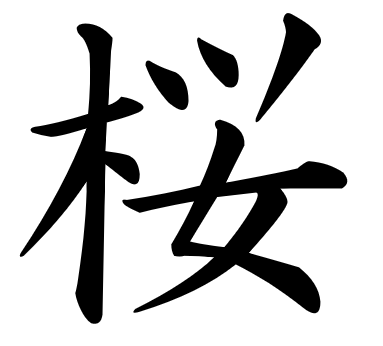
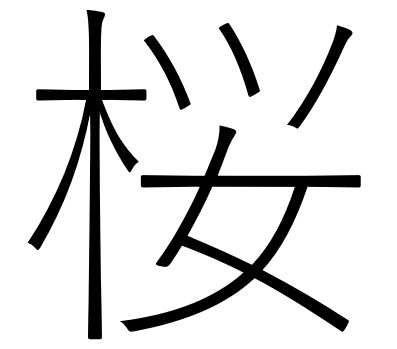
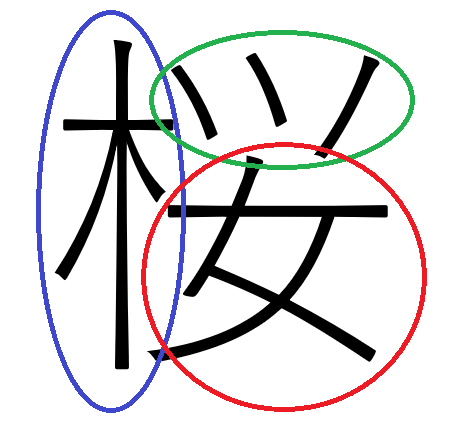
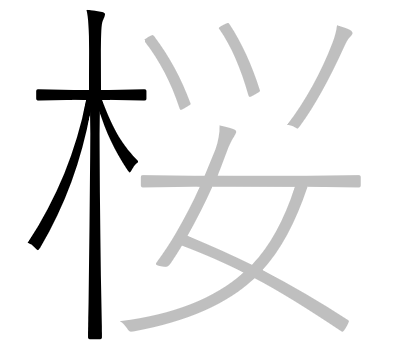
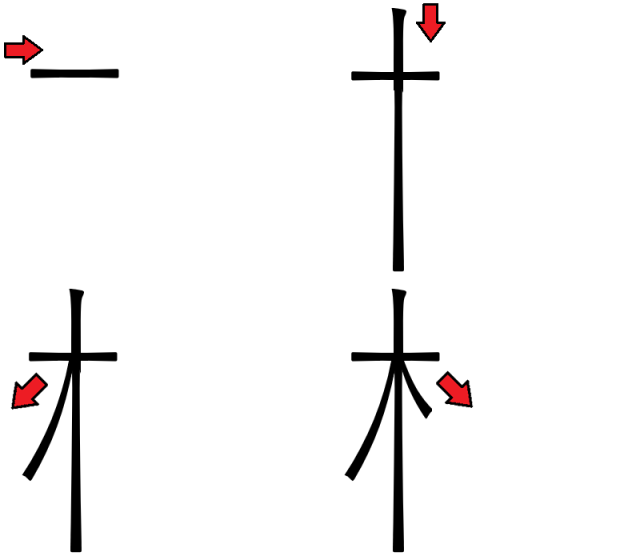

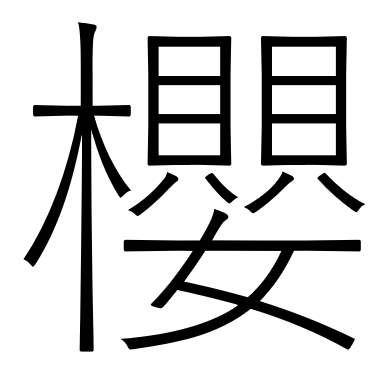
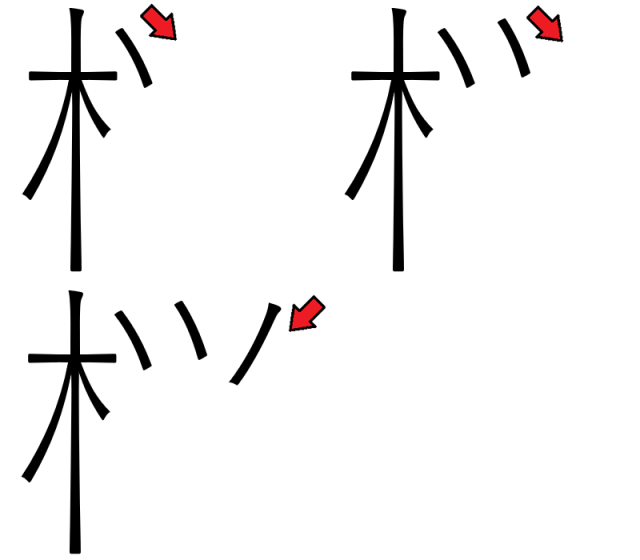
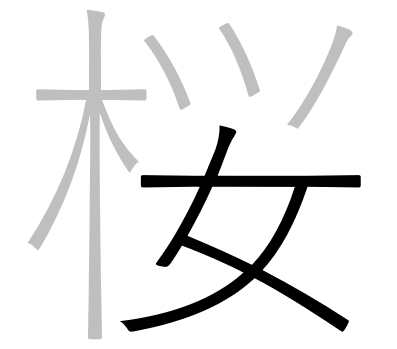
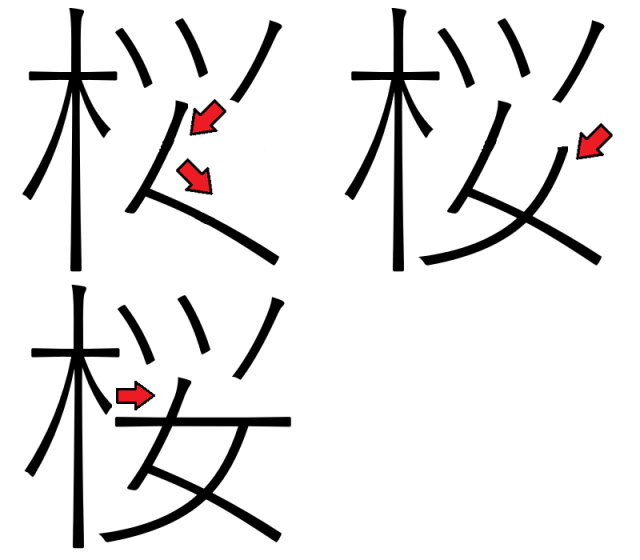
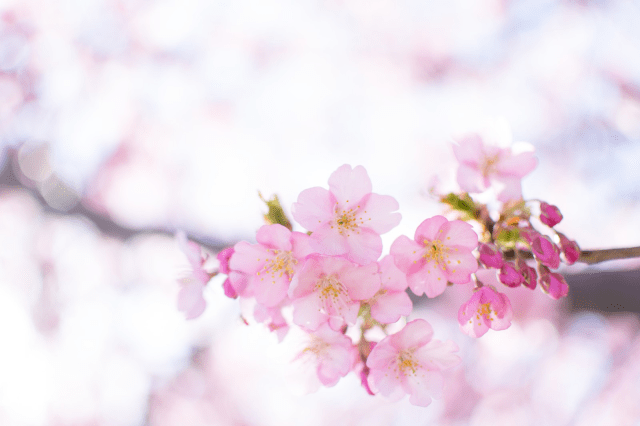
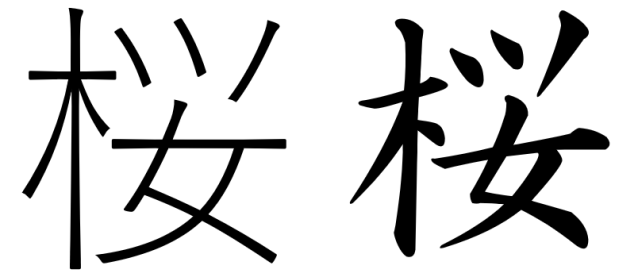
 Taste-testing every single sakura sweet and cherry blossom drink we could find at Mujirushi
Taste-testing every single sakura sweet and cherry blossom drink we could find at Mujirushi Renowned Japanese calligraphy teacher ranks the top 10 kanji that foreigners like
Renowned Japanese calligraphy teacher ranks the top 10 kanji that foreigners like Seven places that aren’t Starbucks where you can get delicious sakura cherry blossom drinks in Japan
Seven places that aren’t Starbucks where you can get delicious sakura cherry blossom drinks in Japan Couldn’t catch the cherry blossoms in full bloom? We’ve got a unique idea for you!
Couldn’t catch the cherry blossoms in full bloom? We’ve got a unique idea for you! Japanese study tip: Imagine kanji characters as fighting game characters, like in this cool video
Japanese study tip: Imagine kanji characters as fighting game characters, like in this cool video McDonald’s new Happy Meals offer up cute and practical Sanrio lifestyle goods
McDonald’s new Happy Meals offer up cute and practical Sanrio lifestyle goods Red light district sushi restaurant in Tokyo shows us just how wrong we were about it
Red light district sushi restaurant in Tokyo shows us just how wrong we were about it Historical figures get manga makeovers from artists of Spy x Family, My Hero Academia and more
Historical figures get manga makeovers from artists of Spy x Family, My Hero Academia and more Anime girl English teacher Ellen-sensei becomes VTuber/VVTUber and NFT
Anime girl English teacher Ellen-sensei becomes VTuber/VVTUber and NFT Sandwiches fit for a sumo served up in Osaka【Taste Test】
Sandwiches fit for a sumo served up in Osaka【Taste Test】 Japanese ramen restaurants under pressure from new yen banknotes
Japanese ramen restaurants under pressure from new yen banknotes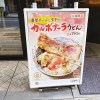 Limited-edition Carbonara Udon will anger noodle purists and pasta lovers 【Taste test】
Limited-edition Carbonara Udon will anger noodle purists and pasta lovers 【Taste test】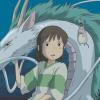 Haku is…Chihiro’s dead brother? Studio Ghibli fans blown away by Spirited Away theory
Haku is…Chihiro’s dead brother? Studio Ghibli fans blown away by Spirited Away theory We try out “Chan Ramen”, an underground type of ramen popular in the ramen community
We try out “Chan Ramen”, an underground type of ramen popular in the ramen community Starbucks Japan adds a Motto Frappuccino to the menu for a limited time
Starbucks Japan adds a Motto Frappuccino to the menu for a limited time All-you-can-drink Starbucks and amazing views part of Tokyo’s new 170 meter-high sky lounge
All-you-can-drink Starbucks and amazing views part of Tokyo’s new 170 meter-high sky lounge French Fries Bread in Tokyo’s Shibuya becomes a hit on social media
French Fries Bread in Tokyo’s Shibuya becomes a hit on social media Studio Ghibli releases new action figures featuring Nausicaä of the Valley of the Wind characters
Studio Ghibli releases new action figures featuring Nausicaä of the Valley of the Wind characters New private rooms on Tokaido Shinkansen change the way we travel from Tokyo to Kyoto
New private rooms on Tokaido Shinkansen change the way we travel from Tokyo to Kyoto Studio Ghibli glasses cases let anime characters keep an eye on your spectacles
Studio Ghibli glasses cases let anime characters keep an eye on your spectacles Tokyo Tsukiji fish market site to be redeveloped with 50,000-seat stadium, hotel, shopping center
Tokyo Tsukiji fish market site to be redeveloped with 50,000-seat stadium, hotel, shopping center Beautiful Ghibli sealing wax kits let you create accessories and elegant letter decorations【Pics】
Beautiful Ghibli sealing wax kits let you create accessories and elegant letter decorations【Pics】 Studio Ghibli releases Kiki’s Delivery Service chocolate cake pouches in Japan
Studio Ghibli releases Kiki’s Delivery Service chocolate cake pouches in Japan New definition of “Japanese whiskey” goes into effect to prevent fakes from fooling overseas buyers
New definition of “Japanese whiskey” goes into effect to prevent fakes from fooling overseas buyers Our Japanese reporter visits Costco in the U.S., finds super American and very Japanese things
Our Japanese reporter visits Costco in the U.S., finds super American and very Japanese things Studio Ghibli unveils Mother’s Day gift set that captures the love in My Neighbour Totoro
Studio Ghibli unveils Mother’s Day gift set that captures the love in My Neighbour Totoro New Japanese KitKat flavour stars Sanrio characters, including Hello Kitty
New Japanese KitKat flavour stars Sanrio characters, including Hello Kitty More foreign tourists than ever before in history visited Japan last month
More foreign tourists than ever before in history visited Japan last month New Pokémon cakes let you eat your way through Pikachu and all the Eevee evolutions
New Pokémon cakes let you eat your way through Pikachu and all the Eevee evolutions Sales of Japan’s most convenient train ticket/shopping payment cards suspended indefinitely
Sales of Japan’s most convenient train ticket/shopping payment cards suspended indefinitely Sold-out Studio Ghibli desktop humidifiers are back so Totoro can help you through the dry season
Sold-out Studio Ghibli desktop humidifiers are back so Totoro can help you through the dry season Japanese government to make first change to romanization spelling rules since the 1950s
Japanese government to make first change to romanization spelling rules since the 1950s Ghibli founders Toshio Suzuki and Hayao Miyazaki contribute to Japanese whisky Totoro label design
Ghibli founders Toshio Suzuki and Hayao Miyazaki contribute to Japanese whisky Totoro label design Doraemon found buried at sea as scene from 1993 anime becomes real life【Photos】
Doraemon found buried at sea as scene from 1993 anime becomes real life【Photos】 Tokyo’s most famous Starbucks is closed
Tokyo’s most famous Starbucks is closed One Piece characters’ nationalities revealed, but fans have mixed opinions
One Piece characters’ nationalities revealed, but fans have mixed opinions We asked a Uniqlo employee what four things we should buy and their suggestions didn’t disappoint
We asked a Uniqlo employee what four things we should buy and their suggestions didn’t disappoint Princesses, fruits, and blacksmiths: Study reveals the 30 most unusual family names in Japan
Princesses, fruits, and blacksmiths: Study reveals the 30 most unusual family names in Japan McDonald’s Japan celebrates cherry blossom season with new cherry frappe and mocha drinks
McDonald’s Japan celebrates cherry blossom season with new cherry frappe and mocha drinks Experience the cherry blossoms early this year with AR flower art and Morinaga foods
Experience the cherry blossoms early this year with AR flower art and Morinaga foods Starbucks Japan’s new sakura donuts look so good it’s like cherry blossom season is already here
Starbucks Japan’s new sakura donuts look so good it’s like cherry blossom season is already here Sakura Skytree photos take Tokyo’s breath away, give kick-start to cherry blossom season【Photos】
Sakura Skytree photos take Tokyo’s breath away, give kick-start to cherry blossom season【Photos】 Starbucks Japan’s cherry blossom powder donuts, sakura-topped cakes bloom onto the menu
Starbucks Japan’s cherry blossom powder donuts, sakura-topped cakes bloom onto the menu Sakura in Japan 2019: The best spots for hanami cherry blossom viewing
Sakura in Japan 2019: The best spots for hanami cherry blossom viewing Delicious cherry blossom-flavored treats are in full-bloom in Japanese stores
Delicious cherry blossom-flavored treats are in full-bloom in Japanese stores Starbucks Sakura Frappuccino blooms in Japan 【Taste Test】
Starbucks Sakura Frappuccino blooms in Japan 【Taste Test】 W.T.F. Japan: Top 5 most difficult kanji ever【Weird Top Five】
W.T.F. Japan: Top 5 most difficult kanji ever【Weird Top Five】 Testing Japan’s gacha capsule toy calligraphy brushes – tranquility for just 200 yen【Photos】
Testing Japan’s gacha capsule toy calligraphy brushes – tranquility for just 200 yen【Photos】 The not-so-fleeting beauty of the cherry blossoms: An alternate perspective
The not-so-fleeting beauty of the cherry blossoms: An alternate perspective New canned sakura liquor beverage appears in Japan, courtesy of Suntory 【Taste test】
New canned sakura liquor beverage appears in Japan, courtesy of Suntory 【Taste test】 Sakura shoes! Converse’s new Japan-exclusive model is made with actual cherry blossoms
Sakura shoes! Converse’s new Japan-exclusive model is made with actual cherry blossoms Cherry blossom curry is set to bring spring to your plate even before the sakura arrive
Cherry blossom curry is set to bring spring to your plate even before the sakura arrive
Leave a Reply